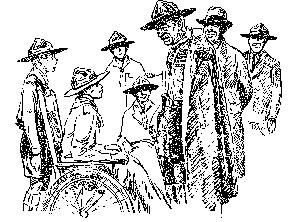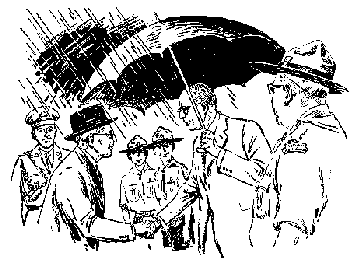The Beginnings
Shortly after Baden-Powell visited Canada in 1910, a group of Londoners formed an official Scouting organization for the city. Although youth had been actively holding meetings with adult help for over a year, this was the first step at providing formal support. London was issued the province's first warrant of organization on September 15, 1910. Scouting quickly grew in the city; the uniforms became a familiar sight on city streets.
By the end of World War I, and the loss of a lot of adult leadership, numbers had dropped to a handful with only one troop remaining active. But Scouting was soon flourishing again, and with it, Wolf Cub Packs. Made official in 1916, Packs become popular, and so too did the involvement of female Cub masters!
By 1929, both sections were growing, and the creation of a Rover crew was underway. In 1931 there were 375 Scouts, 405 Cubs, 58 Rovers and 12 Sea Scouts. 1932 marked the introduction of London's first permanent campsite, Beach 'O Pines, a wooded property on the shore of Lake Huron near Grand Bend. An in 1935, the Chief Scout of the World, Lord Baden-Powell visited London as part of his North American tour.
Chief Scout's Visit
Tuesday, May 14, 1935 saw over 2,500 boys and girls gathered at Queen's Park in London to welcome Lord Baden-Powell. The 78-year old founder had been touring for several months, and missed the civic reception to rest for his visit with the youth members of Scouting.
Lady Baden-Powell accompanied him on his tour, which reunited him with many London friends from his military years in South Africa.
B-P spoke to the crowd, noted that London Scouting was celebrating its 25th Anniversary, and that over 44,000 Canadian youth were members of Troops and Packs, along with 42,000 Canadian Guides and Brownies. B-P visited with the participants, then departed on his private railroad car.
Scouting Steps Forward (1937-1941)
Late in April 1937, London Scouting had an opportunity to show its abilities. A hard rain had fallen for several days on the deep snow. The runoff of 3-inch rain, combined with the melting snow clogged the river and the water spilled over the banks, flooding the city's core. Water eventually reached 30 feet above normal levels, adding to the problems. A dam near St. Marys broke, and a wave several feet high slammed into the north and northwest parts of the city. 6,000 Londoners were forced from their homes, and still the rain continued.
After a radio appeal, over 250 local Scouting youth reported to police headquarters. Some helped the overworked police force; others helped refugees to the relief areas, still more directed traffic around bridges, or provided crowd control.
The manned boats helped rescue people from their rooftops. Scouts answered telephones, acted as messengers releasing police and firemen to more important duties.
At the London armories, they staffed the relief haven, providing blankets, setting up cots, boiling drinking water and making meals. They worked around the clock, until the river started to subside after four days of flooding.
Debris was everywhere; houses were destroyed or covered in a thick brown muck. And now, more problems. The local health unit had to close much of the area and Scouting delivered the bulletins warning people of the need to sterilize their homes and have them inspected. Inoculations against typhoid were organized and replacement supplies were needed. All of these messages were delivered by Scouts. It was London Scouting's good turn of the year, and recognized by the provincial council with a Certificate of Merit.
The war years saw many Scouts join the services. B-P died in 1941, and London got a new campsite, closer to London. Located just a few miles west of the city limits, on a farmer's property straddling Dingman's creek, the camp was known as "Onkwe", meaning "beside the running waters".
Camp Onkwe
After the war ended, Lady Baden-Powell returned to London in June 1946, and 4,000 members of Guiding and Scouting jammed in Labatt Park. That fall, Lord Rowallan - Chief Scout of the British Commonwealth and Empire, visited the city and met with over 2,000 youth in Gibbons Park for a day of fun and demonstrations. He noted during his speech that the 8th London had been in continuous operation since its creation in 1910, the longest in Canada.
Spencer Lodge
In 1956, after a year of construction, Spencer Lodge was dedicated in an official ceremony attended by the Governor-General of Canada. Major-General Spencer provided the gift of the monies needed to purchase the land and the creation of a permanent headquarters in what was then the northern limits of the city.
For his generous support, Major-General Spencer was awarded the Silver Wolf by Vincent Massey, the Governor-General. Memories of Beach O' Pines and Onkwe are kept in Spencer Lodge, where two of the meeting areas carry those names.
A New Crest
In 1957 a contest to design a new crest for London Scouting saw the creation of our current badge. Created by PL Cliff Bilyea of the 22nd London Troop, the badge features the Y of the forks of the Thames, the trees to represent the Forest City and the castle to denote our history as a garrison town.
Camp Sylvan Opens
In 1960, with Scouting in London swelling to nearly 5,000, Camp Onkwe was replaced by Camp Sylvan (sylvan=green). The ghost town of the village that had started back in the late 1800's still remains in the foundations scattered around the property. Camp Sylvan was 240 acres of wooded rolling hills, a great example of Carolinian forest. Trails criss-cross the property, providing lots of activity for participants.
In 1961, the first covered wagons rolled into Frontierland and a new Cub Camp facility was born. The ghost town of Sylvan returned, with the creation of the blacksmith's shop, a store and a sleeping area, all on the historic lines of an 1800's village.
******
Scouting in London continues to provide many exciting opportunities and adventures for youth. The many changes to the program keep it alive and important. But the central theme remains: developing today's youth to be tomorrow's leaders.
* Much of the information provided on this page is taken from "Keen For Adventure", written by William Corfield. The book was a Centennial project in 1967. The artwork was done by Kevin & Clare Bice.



